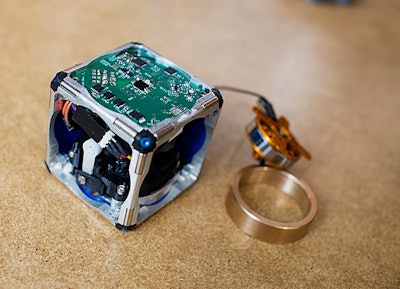 A prototype of the self-assembling cubes. Credit: M. Scott Brauer/MIT News
A prototype of the self-assembling cubes. Credit: M. Scott Brauer/MIT NewsAny time the words “like…in the movie ‘Terminator II'” are uttered in a news article, we tend to take notice. Worries of a post-apocalyptic future where the machines have taken control, this bit of news out of MIT is still pretty cool.
A team of researchers there have built self-assembling robots that could be the building blocks of the future, according to a report from MIT News. Known as M-Blocks, these robotic cubes have no external moving parts, but are able to jump, roll and climb over one another in order to group together and form new shapes.
The way the cubes do this is a combination of a flywheel inside the cube and magnets on the outside. The flywheel, which can reach up to 20,000 revolutions per minute, spins up to speed and when it is stopped gives momentum to the cube. That’s when magnets placed on the edges and face of the cube guide them into place.
The ultimate goal is to make the cubes even smaller. Here’s the money quote: “the ultimate aim of most such research is hordes of swarming microbots that can self-assemble, like the ‘liquid steel’ androids in the movie ‘Terminator II.’ And the simplicity of the cubes’ design makes miniaturization promising.”
However, even at their current size the researchers say the cubes could be used to repair bridges or raise and reposition scaffolding during construction projects. The researchers even say the cubes could group together to form heavy equipment. Just imagine: buy one set of cubes that can transform into an excavator, a backhoe and a wheel loader.
Be sure to watch video of the cubes in action below.
[youtube 6aZbJS6LZbs nolink]









